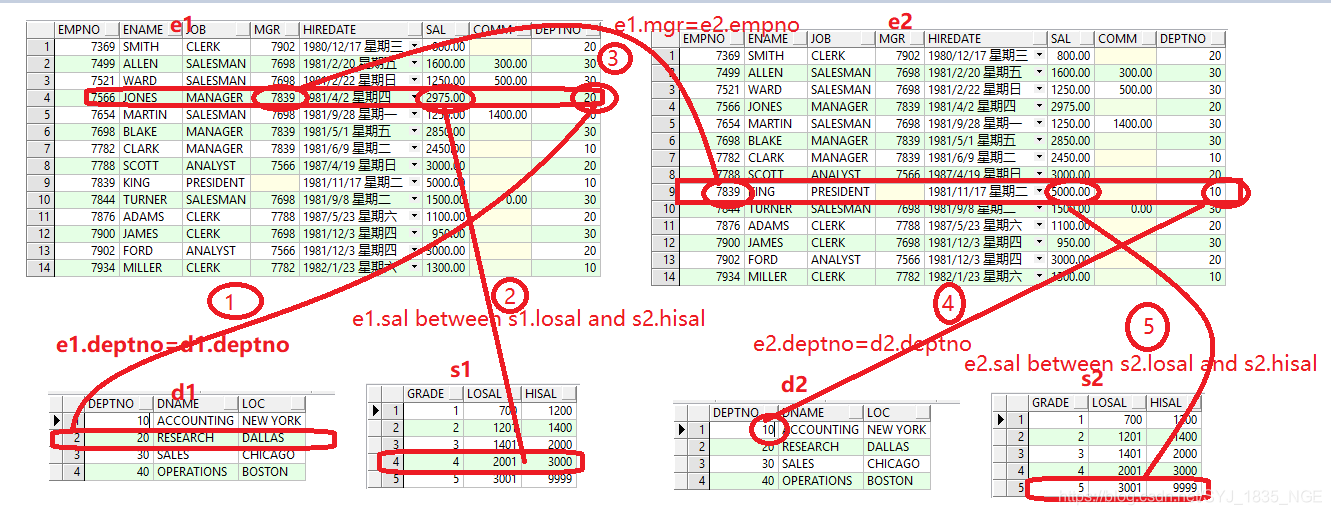Oracle学习三
-
有关连接查询和最查询的解释和练习请参考:mysql的连接查询
-
使用的是oracle下的scott用户下的四张表
select * from dept; select * from emp; select * from salgrade; select * from bouns;
多表查询
-
1、查询员工编号,员工姓名,员工部门编号,员工部门名称,员工部门地址,中文显示员工工资等级,领导编号,领导姓名,领导部门编号,领导部门名称,中文显示领导工资等级
主要注意的地方:员工和领导不一定在一个部门即(员工表.deptno 不一定等于 领导表.deptno )

通过上表分析得知:select e1.empno,e1.ename,d1.deptno,d1.dname,d1.loc,s1.grade,e1.mgr,e2.ename,e2.deptno,d2.dname,s2.grade from dept d1,emp e1,salgrade s1,emp e2,dept d2,salgrade s2 where d1.deptno = e1.deptno and e1.sal between s1.losal and s1.hisal and e1.mgr = e2.empno and e2.deptno = d2.deptno and e2.sal between s2.losal and s2.hisal -- ===========================六表联查=========================================== select e1.empno,e1.ename,d1.deptno,d1.dname,d1.loc,decode(s1.grade,1,'一级',2,'二级',3,'三级',4,'四级',5,'五级') "slaLevel",e1.mgr,e2.ename,e2.deptno,d2.dname,decode(s2.grade,1,'一级',2,'二级',3,'三级',4,'四级',5,'五级') "slaLevel" from dept d1,emp e1,salgrade s1,emp e2,dept d2,salgrade s2 where d1.deptno = e1.deptno and e1.sal between s1.losal and s1.hisal and e1.mgr = e2.empno and e2.deptno = d2.deptno and e2.sal between s2.losal and s2.hisal -
2、查询员工编号,员工姓名,领导编号,领导姓名
-- 连接查询 select e1.empno,e1.ename,e1.mgr,e2.empno from emp e1,emp e2 where e1.mgr = e2.empno; -- 内连接查询 select e1.empno,e1.ename,e1.mgr,e2.empno from emp e1 inner join emp e2 on e1.mgr = e2.empno;
外连接
-
1、查询员工编号,姓名,领导编号,领导姓名,包括没领导的
-- left join on方式(主要查询的主表是员工表)左外连接主表放到from后面 select e1.empno,e1.ename,e1.mgr,e2.empno from emp e1 left outer join emp e2 on e1.mgr = e2.empno; ----Oracle的(+)方式(添加+号的一方以不添加+的一方为准)(即不添加+的一方为主表) select e1.empno,e1.ename,e1.mgr,e2.empno from emp e1,emp e2 where e1.mgr=e2.empno(+) -
2、查询出所有部门信息(包括没员工的部门)及部门下的员工信息
--left join on方式一 select d.*,e.* from dept d left join emp e on d.deptno=e.deptno --Oracle的(+)方式二 select d.*,e.* from dept d,emp e where d.deptno=e.deptno(+)
子查询
-
1、查询比雇员7654工资高,同时从事和7788的工作一样的员工
--(1)首先查询雇员7654的工资 select e1.sal from emp e1 where e1.empno = 7654 --(2)查询7788从事的工作 select e2.job from emp e2 where e2.empno = 7788 --(3)sal>(1)且job=(2) select * from emp where sal>( select e1.sal from emp e1 where e1.empno = 7654 ) and job=( select e2.job from emp e2 where e2.empno = 7788 ); -
2、查询每个部门最低工资及最低工资的部门名称和雇员名称
(1)根据部门分组查询最低工资
(2)查询(1)中的、员工表和部门表三个表,要满足三个条件:
1.(1)表中的deptno和员工表的deptno相等
2.(1)表中的最低工资和员工表中的最低工资相等
3.员工表中的deptno和部门中的deptno相等
-- (1)查询每个部门的最低工资 select deptno,min(sal) from emp group by deptno -- (2)最低工资的部门名称和雇员名称(重点) select e1.minsal,d.dname,e.ename from ( select deptno,min(sal) minsal from emp group by deptno ) e1,emp e,dept d where e1.deptno = e.deptno and e1.deptno = d.deptno and e1.minsal = e.sal;
练习
-
1、找到员工表中工资最高的前三名
每一张表中都会有一个隐藏的字段rownum
但是rownum只支持小于号的比较
select 列名1 ...列名n from ( select 列名1 ...列名n from 表名 order by 列名1 ) where rownum <=N(抽出记录数) order by rownum asc -- ======================== select * from ( select sal from emp order by sal desc )where rownum < 4 -
2、找到员工表中薪水大于本部门平均工资的所有员工
--(1)查询本部门的平均工资(按照部门进行分组) select deptno,avg(sal) avgsal from emp group by deptno --(2)总查询 select e.* from ( select deptno,avg(sal) avgsal from emp group by deptno ) temp,emp e --条件就是本部门员工部门和(1)中的部门是否相等(e.deptno = temp.deptno)&& 薪水>平均薪水 where e.sal>temp.avgsal and e.deptno = temp.deptno -
3、统计每年入职的员工个数(考察的是行列转换)
通过to_char将日期中的年份提出
decode的使用
-- 每年的总数 select count(*) "hcount",to_char(hiredate,'yyyy') "hdate" from emp group by to_char(hiredate,'yyyy') -- 总共入职的总数 select decode(hdate,'1980',hcount),decode(hdate,'1981',hcount), decode(hdate,'1982',hcount),decode(hdate,'1987',hcount) from ( select count(*) hcount,to_char(hiredate,'yyyy') hdate from emp group by to_char(hiredate,'yyyy') ) temp; -- 再将每一列进行聚合(聚合函数sum、min、max、avg) select sum(hcount) "total" ,sum(decode(hdate,'1980',hcount)) "1980",min(decode(hdate,'1981',hcount)) "1981", max(decode(hdate,'1982',hcount)) "1982",avg(decode(hdate,'1987',hcount)) "1987" from ( select count(*) hcount,to_char(hiredate,'yyyy') hdate from emp group by to_char(hiredate,'yyyy') ) temp;
分页查询
-
1、查询员工表,将员工工资进行降序查询,并进行分页取出第一页,一页三条记录
--1.查询员工表,将员工工资进行降序查询,并进行分页取出第一页,一页三条记录 select rownum,temp.* from ( select * from emp order by sal desc ) temp where rownum <=3 --2.rownum不能做大于查询(上面的语句还没有出现rownum) select * from ( select rownum r,temp.* from ( select * from emp order by sal desc ) temp ) page where page.r between 4 and 6总结得出Oracel的分页公式:
-- oracle分页公式: -- pageNo = 第几页 -- pageSize = 每页多少条 select * from ( select rownum r,temp.* from ( select * from 表名 order by 列名 desc ) temp ) page where page.r between (pageNo-1)*pageSize+1 and pageNo*pageSize
集合运算
-
1、查询工资大于1200并且job是SALESMAN(intersect) and(交集)
select * from emp where sal > 1200 intersect select * from emp where job = 'SALESMAN'; -
2、查询工资大于1200或者job是SALESMAN(union) or (并集)
--union all(加上all不去重) select * from emp where sal > 1200 union select * from emp where job = 'SALESMAN'; -
3、求工资大约1200和job是SALESMAN的差集(minus)有主从表之分(差集)
select * from emp where sal > 1200 minus select * from emp where job = 'SALESMAN';exists / not exists
-
4、查询出有员工的部门
/* select ... where exists(查询语句) exists:当查询结果不为null,返回true 当查询结果为null,返回false */ -- 查询部门 select d1.deptno from dept d1 where exists( --查询员工 select e.* from emp e where e.deptno = d1.deptno ) -
5、查询出没有员工的部门
-- 查询部门 select d1.deptno from dept d1 where not exists( --查询员工 select e.* from emp e where e.deptno = d1.deptno )
### 全部教程是本人自己在学习过程中的总结和练习,都很基础写下来的目的主要是方便自己和他人的复习理解,也消除了笔记写下找不到的缺点。如有需要什么笔记或者文档可以留言。





 该博客围绕Oracle学习展开,介绍了多表查询、外连接、子查询、分页查询和集合运算等内容。使用Oracle下scott用户的四张表进行操作,包含多个查询示例,如查询员工与领导信息、各部门最低工资等,还涉及练习及分页公式总结。
该博客围绕Oracle学习展开,介绍了多表查询、外连接、子查询、分页查询和集合运算等内容。使用Oracle下scott用户的四张表进行操作,包含多个查询示例,如查询员工与领导信息、各部门最低工资等,还涉及练习及分页公式总结。
















 2730
2730

 被折叠的 条评论
为什么被折叠?
被折叠的 条评论
为什么被折叠?








